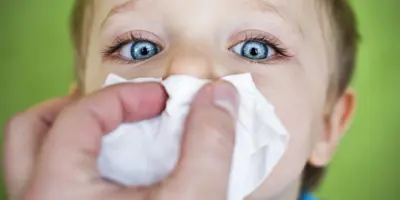1 person found this helpful

Furry felines aren’t always a welcome addition to the family, especially if you start coughing or your nose runs. These are all signs of a cat allergy. Skin rash too is a common sign.
But how can you be certain that your furry feline friend is really the cause of your watery eyes? We’re going to run through the most common cat allergy symptoms and explain what actually triggers the reaction.
Cat allergy symptoms
Symptoms of a cat allergy:
- Skin rash on the face/chest.
- Coughing/wheezing.
- Red, itchy, watery eyes.
- Sneezing.
- Runny, itchy nose.
- Redness on the skin where a cat has bitten, licked, or scratched.1
When suffering from cat allergy symptoms, eyes tend to get watery, a runny nose and sneezing when allergens come into contact with mucous membranes (on the mouth, nose and eyelids) and the respiratory tracts (nose, throat and lungs). As for a cat allergy rash, hives or redness, this occurs as a reaction to direct skin contact with the cat.1
Tip: Keep a soft tissue, like Cushelle Regular Tissues, with you to catch the sneezes. They’re gentle on your skin while being strong enough to stand up to all that nose wiping.
What causes cat hair allergy symptoms?
Many people think that their reaction is an allergy to cat hair, but it isn’t really the fur that’s the problem. It’s actually a protein in cat dander (dried flakes of skin) that triggers the allergic reaction. So, while it may seem that the issue is cat hair allergy symptoms, the irritation is actually an allergy to proteins, which are also found in cat saliva and urine.1
Still convinced cat hair is the culprit? That’s because those fluffballs lick their coats, spreading their saliva over the fur—not to mention, dander also gets tangled up in their fur. These allergens can sit in upholstered furniture, carpets and mattresses, and can also pass into fine dust particles in the air. They can even be transported by the cat owner to different places.
Even hairless cats produce the protein Fel d 1.2 Even though they don’t have any fur to trap it, they do still spread it onto their skin during grooming via their saliva. And keep in mind that they also shed dead skill cells containing the allergen. So, the idea that there are particular cat breeds (or genders) that are hypoallergenic is in fact just a myth.1
How soon can you see signs of being allergic to cats?
You can start to show symptoms, such as a cat allergy rash, within a few minutes of being exposed to the allergen, or they can take hours to appear.1 You don’t even need to have been in direct contact with a cat for some symptoms to appear. As we’ve seen, the allergens can travel further afield.
Can you develop symptoms of being allergic to cats later in life?
Typically, a cat allergy will start in your childhood or your teenage years. So if you’ve had a cat before and you were fine, the likelihood is you’ll always be fine. However, symptoms of cat allergies in adults can appear later in life, even when there weren’t any signs of it previously.2
This can often come down to building up a tolerance in earlier life. When you live for a prolonged time with an allergen (like the proteins in your specific cat’s dander, saliva and urine), you can become tolerant to that particular trigger. But then when you come into contact with other cats, you can show symptoms. However, this is rare.2
It’s also useful to note that not all cats create equal allergic responses. Cats produce different levels of allergens, meaning that one cat might prompt symptoms of cat allergies in adults, while another cat doesn’t.2
Are cat allergy symptoms similar to other allergy symptoms?
Many of the symptoms of being allergic to cats are the same as the symptoms you can experience when you’re having an allergic reaction to something else. Here are some of the most common allergies:3
- Hay fever – an allergy to tree, grass and/or weed pollen.
- Dust mites – it’s actually the proteins in dust mites’ faeces and decaying bodies that causes the allergic reaction.
- Mould – the allergy is to the small particles that mould releases into the air that are then breathed in.
- Other pet allergies (including cat dander allergy).
With any of these cat allergy symptoms, eyes can go itchy, watery, or red, you can experience sneezing, coughing, wheezing, a runny nose, rash, cat dander allergy (swollen nasal passages) and/or a worsening of eczema/asthma symptoms. So, how do you know if it’s definitely a cat allergy, and not something else?
How to diagnose a cat allergy
The main way to figure out the cause yourself is to notice what’s happening when you experience the symptoms. You may even want to keep a diary if it’s particularly difficult to identify the trigger. Here are a few things to take note of when you start experiencing cat allergy symptoms:
- Where are you?
- What’s near you?
- When is it happening?
Sometimes you’ll have a good idea about what’s causing the reaction. This is particularly the case with a cat allergy skin rash – if you get redness on your skin where a cat has licked, scratched or bitten you.
It’s worth bearing in mind, though, that cat hair can also carry other airborne allergens, like the aforementioned dust mites, mould and pollen, so it might be those particles on your cat that are causing the issues, not the protein in their dander, urine or saliva.
The best course of action is to discuss all of this with your GP, and they’ll be able to diagnose as well as offer treatment and advice. You might get a referral to have a skin prick test or blood test, or even to see an allergy specialist.
A skin prick test is very common and will probably be your health professional’s first port of call.2 This involves putting a drop of liquid containing the allergen on your forearm. They will then gently prick your skin underneath the droplet. You’ll then wait about 15 minutes to see the response. If a red, itchy bump develops, that indicates an allergy.
A blood test works by a sample of your blood being analysed. They’ll look to see if your immune system produces specific antibodies as a response to the allergen.2
If you think you’re allergic to cats, there are ways to deal with a pet allergy. The first step is understanding what the signs of cat allergy are, and now you’ve ticked that box, you can take steps to deal with the issue.
Sources
1 American College of Allergy, Asthma, & Immunology; Pet Allergies
Related articles
The truth behind hay fever causes: hay fever myths debunked
What causes hay fever? We debunk the myths surrounding hay fever triggers and answer common questions like is hay fever contagious? Find the answers here.

5 natural and herbal remedies for hay fever to try at home
Want to know how to treat a pollen allergy at home? Discover five options, from herbal teas and steaming to herbal remedies for hay fever relief, here.

4 tips for unblocking a newborn’s nose
Learn how to blow a baby's nose and how to teach nose blowing to older children with this guide on how to clean baby nose blockages.

The worst places for pollen concentration
Discover the difference in pollen concentration across the U.K. Find out the facts about pollen: city versus countryside, and inland versus coast, here.

Nosebleeds Causes: Why They Happen and How to Prevent Them
Learn about the most common nosebleeds causes here with Cushelle. Find out the link between a cold and a nosebleed, plus ways of preventing them.

A guide to cross-reactivity allergy issues
Are you looking for info about cross-reactivity? Oral allergy syndrome? Latex-fruit syndrome? Discover the facts, and what you can do about it, here.



